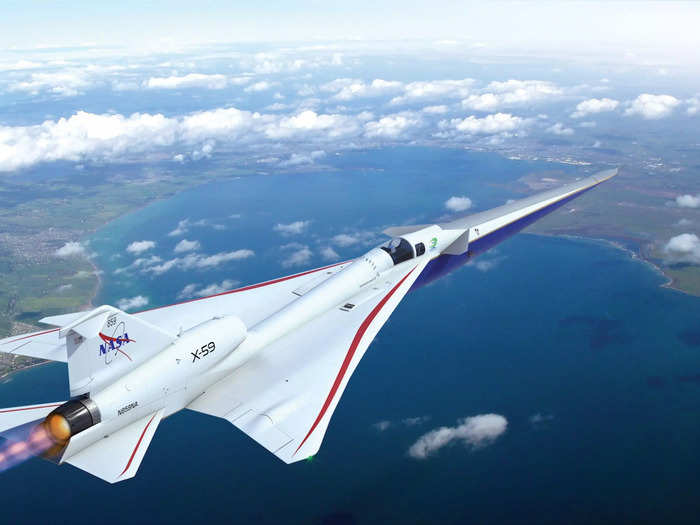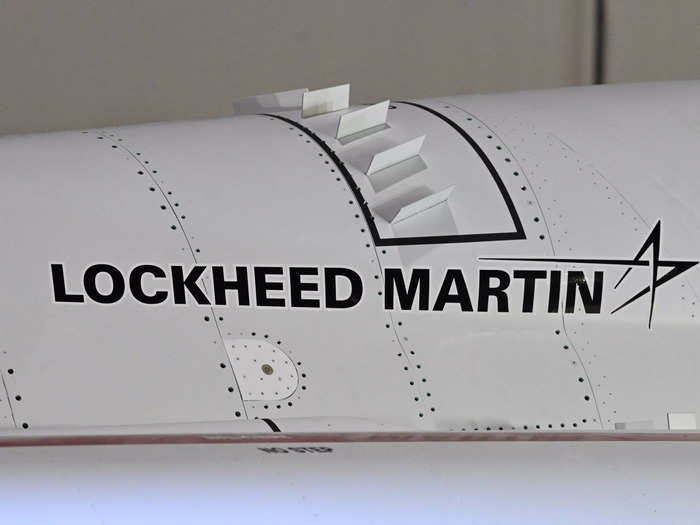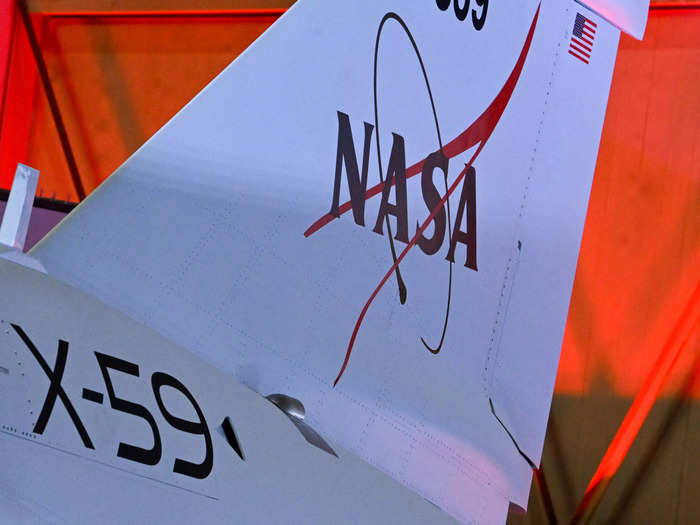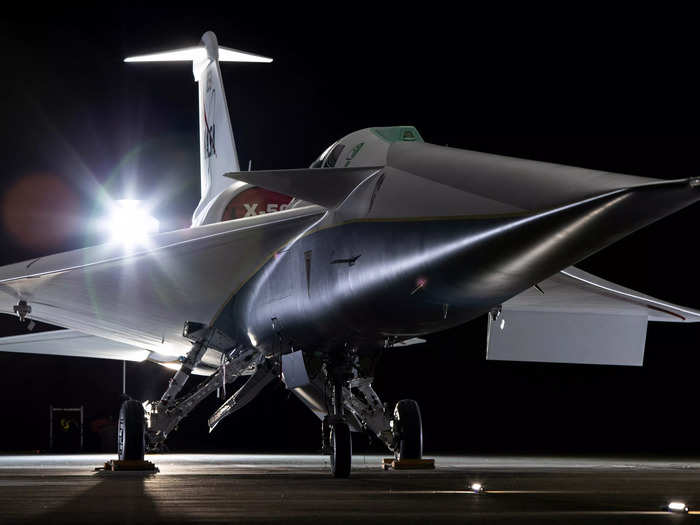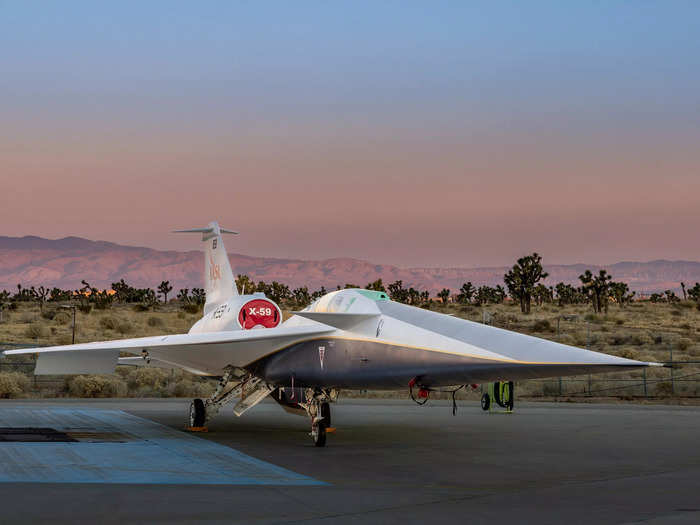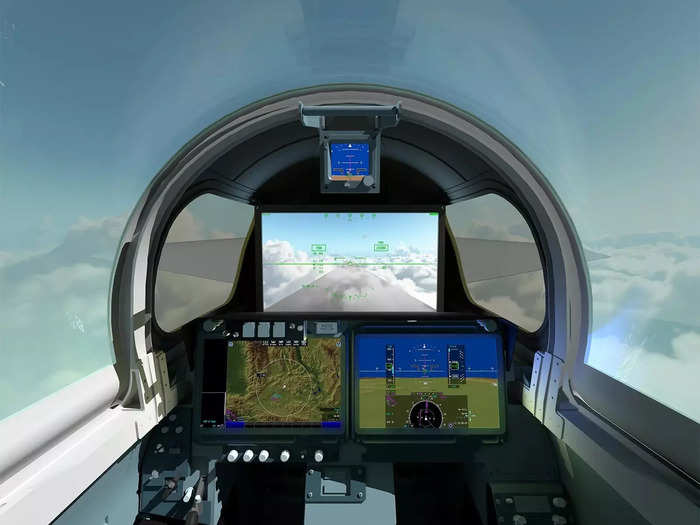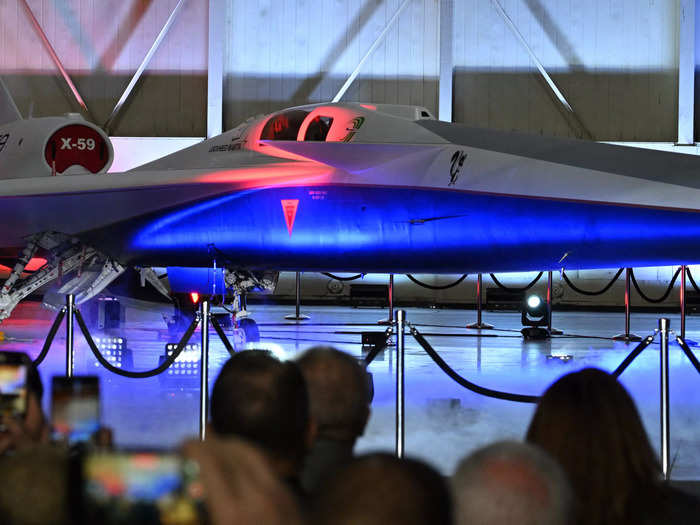The experimental quiet supersonic aircraft X-59.Lockheed Martin/Garry Tice/Handout via REUTERS
- NASA unveiled the X-59, an experimental supersonic aircraft designed to produce a quieter sonic boom.
- The explosive noise happens when an aircraft travels faster than the speed of sound.
Earlier this month, NASA unveiled the X-59 aircraft, its experimental supersonic jet designed to travel faster than the speed of sound — with a "sonic boom" no louder than the bounce of a basketball.
The X-59 is a 100-foot research aircraft designed to create a quieter sonic boom more suitable for commercial travel, following the end of the Concorde, the first supersonic commercial airplane, in 2003. It features a streamlined nose that makes up about a third of its length and a windowless cockpit.
Dubbed the Quiet Supersonic Technology or QueSST for short, NASA's mission will operate through 2027 and aims to have its first flight later this year.
What happens during a sonic boom
An artist's concept shows the X-59 in flight, a design being developed by NASA and Lockheed Martin to create a faster-than-sound plane with a quieter sonic boom. NASA/Lockheed Martin
A sonic boom occurs when an aircraft exceeds the speed of sound. Normally, whenever any aircraft travels, it creates pressure waves in the air in front of and behind it — similar to how a boat produces waves in the water.
Those pressure waves travel at the speed of sound. So when an aircraft surpasses that speed, it compresses the pressure waves in front of it to the point they produce a shock wave.
That shock wave is what you hear as a sonic boom.
A sonic boom can generate sounds of up to 110 decibels, similar to a thunderclap or explosion strong enough to shatter windows and cause tremors. Trained fighter pilots become acclimated to traveling at Mach speeds, but not so much the average commercial airline passenger.
There are no commercial supersonic planes currently in operation since the permanent retirement of the Concorde. Developed in the 1960s, the Concorde was the first supersonic passenger-carrying commercial airplane built by the UK and France. Traveling at speeds up to Mach 2, the aircraft reduced travel between New York and London to only three hours.
Only 14 Concordes went into service before it was retired in 2003 due to its costly operation, risks, and noise.
The X-59 aims to change that.
The Quesst mission seeks to reduce "the loudness of a sonic boom reaching the ground to that of a gentle thump, if it is heard at all," the agency said.
World travel in half the time
The logo of Lockheed Martin on the side of its X-59 experimental supersonic jet. ROBYN BECK/AFP via Getty Images
The space agency developed the X-59 with aerospace company Lockheed Martin in a $247.5 million contract. The jet was cleared for assembly in 2019, three decades since the last large-scale piloted X-plane.
"This is a major accomplishment made possible only through the hard work and ingenuity from NASA and the entire X-59 team," NASA Deputy Administrator Pam Melroy said in a statement. "In just a few short years, we've gone from an ambitious concept to reality. NASA's X-59 will help change the way we travel, bringing us closer together in much less time."
Latest in a series of X-plane supersonic jets
NASA's logo on the side of its X-59 experimental supersonic jet. ROBYN BECK/AFP via Getty Images
The X-59 is the latest in a series of experimental supersonic aircraft called X-planes. It includes the X-1, the first manned supersonic plane, and the X-15, which holds the record for the fastest speed ever achieved by an aircraft at Mach 6.72 (about 4,520 mph).
The future of commercial supersonic travel
The experimental quiet supersonic aircraft X-59 is seen parked in a hangar. Lockheed Martin/Garry Tice/Handout via REUTERS
The development and operation of the Concorde were so costly that the aircraft wasn't profitable in its 30 years of service.
Other startups and aerospace manufacturers are also looking to get into hypersonic travel to significantly cut down global travel time, like the Boom Supersonic's Overture jet and Venus Aerospace's Stargazer.
Airline companies are keen on getting in on the supersonic action as well, with American Airlines and United Airlines already ordering the ultra-fast aircraft.
"If you look back 100 years, a lot of the advanced mobility technologies, including railroads and airplanes, started out as premium experiences," Craig Nickol, senior advisor at NASA Headquarters, told CNN in 2022, "but as technology advanced and costs came down, they became available to the general public."
"One of the long-term goals is to make this form of high-speed travel available as a widespread application, and there's really no reason why it can't happen," Nickol added.
A streamlined nose
The experimental quiet supersonic aircraft X-59 is seen parked on tarmac in Palmdale, California. Lockheed Martin/Garry Tice/Handout via REUTERS
The X-59's unique design reduces the noise of the sonic boom to just 75 decibels, about as loud as a vacuum cleaner, due to its extra long nose.
"It will be significantly quieter than Concorde or any other supersonic aircraft that exist today," Nickol said. "It's extremely long and thin — it's almost 100 feet long — but has a wingspan of only about 29 feet. The nose is a distinguishing feature on this aircraft: it's about a third of the length."
A windowless cockpit
Artist rendering of the eXternal Vision System (XVS) as installed on the X-59 QueSST. The system blends virtual and augmented reality on a display screen mounted in what normally would be the pilot's forward line of sight. NASA
The X-59 also doesn't have an actual foward-facing window because of the plane's streamlined nose. Instead, the aircraft uses a eXternal Vision System in the cockpit, a monitor displaying high-definition real-time imagery of what's in front of it using externally mounted cameras and an augmented reality symbology overlay.
The XVS "is designed to create equivalent or better levels of performance and safety to that of forward-facing windows on today's aircraft," NASA said in a 2019 release.
Test flights
NASA's and Lockheed Martin's X-59 experimental supersonic jet is unveiled during a roll-out ceremony in Palmdale, California. ROBYN BECK/AFP via Getty Images
While the X-59 is not meant to be a prototype for commercial supersonic travel, its design and technology could inform the future of commercial supersonic flight.
"Any future design of a low boom commercial aircraft for supersonic flight will certainly be different than this, although some of the design elements could translate directly over," Nickol said.
Later this year, NASA will conduct a series of test flights over residential areas of the US to survey residents and gauge the noise of the sonic boom. The test data will be provided to industry regulators to demonstrate the ability of quiet supersonic travel in a commercial capacity.
"By demonstrating the possibility of quiet commercial supersonic travel over land, we seek to open new commercial markets for US companies and benefit travelers around the world," Bob Pearce, associate administrator for aeronautics research at NASA Headquarters in Washington, said in a statement.

